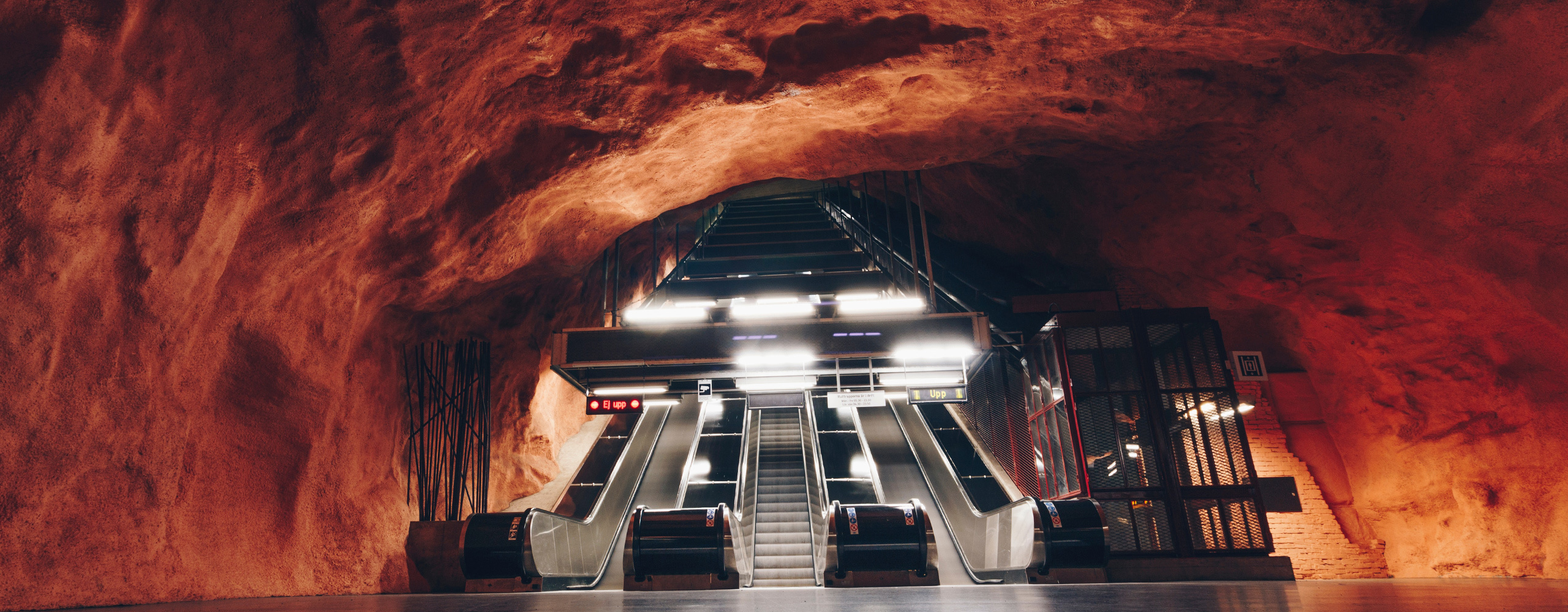
Reinforcing a tunnel face using grouted fiberglass bolts (2016)
The aims of this work is to study the influence of face reinforcement on the tunnel stability and to check if the creep behavior of the rock may induce a potential jamming of the TBM during the excavation stop.

Parking Ramp over Light Rail Station (2016)
A parking ramp expansion has been proposed at Terminal 1-Lindbergh to be constructed over the north end of the Metro Transit Light Rail (LRT) station. Itasca assessed the magnitude of the principal impacts by conducting three-dimensional geostructural analyses of the LRT station using 3DEC. Of the six designs evaluated, all but one option were predicted to be geostructurally feasible.

Geometry Model for the Follo Line Project (2016)
The Follo Line project is the largest railway project in Norway in modern times. The Follo Line is a high-speed railway partly in tunnel from the traffic hub at Ski to Oslo central station. The project comprise a 20 km long tunnel. The new railway is passing through central Oslo, beneath existing infrastructure which creates challenging conditions due to overlapping tunnels and multiple intersections.

Fountain Slide – Slope Stabilization using Micropiles and Anchors (2016)
Fountain Slide has a long history of stability problems. The slope is bounded downhill by the Fraser River and uphill by a highway and a railway. This project stage focused on stabilization of a section of the railway that has suffered extensive damage to its retaining system.

Back-Analysis of Initial Stress at Shallow Depth – A Case Study (2016)
At shallow depth, the initial stress state can significantly affect the behavior of the rock mass around excavations, but stress measurements are usually subjected to high levels of uncertainty. This was the case at the Odenplan railway station in Stockholm where unexpectedly large deformations were measured during the excavation.

Regional-Scale Stress Model of the Stockholm Area (2016)
New metro lines are planned in Stockholm, comprising a total length of approximately 20 km with 10 new stations, mostly located underground. One of the new lines will pass under Saltsjön (a bay of the Baltic Sea) and through a major regional large-scale geological structure. The stress magnitudes and orientations around the structure are highly uncertain, and stress measurements are not practically possible near the structure. To quantify possible stress conditions near the structure, discontinuum threedimensional numerical modeling was conducted.

Liquefaction Risk Mitigation using Jet Grouting Cells (2016)
Trevi Group has been involved in the design-build of a commercial building in Turkey in an area prone to liquefaction. The foundation of the building is located approximately 10 m below original grade, which still leaves about 10-12 m of potentially liquefiable sand underneath the bottom slab.

Tunneling in Mixed Face Conditions (2015)
A research project on tunneling in mixed face conditions (rock-soil) was carried out with the aim to increase the knowledge and to better understand deformation mechanisms when these particular conditions arise. A back analysis of a case study involving the tunnel passage under the Maria Magdalena church was performed as a second task of the project, in which soil stratigraphy, rock/soil reinforcement, and extraction sequence were simulated explicitly and in detail.

Guidelines on Design of Rock Excavations (2015)
In 2009, the Swedish National Rail Administration presented a handbook with guidelines for the design of the load-bearing structure of rock tunnels. Following the merging of several transport administrations into The Swedish Transport Administration, an updated version of the handbook was required.

Chenab Railway Bridge Abutments (2015)
The Udhampur-Srinagar-Baramulla Rail Link (USBRL) project is a railway line linking the Kashmir Valley to the rest of India through the Himalayas. At 110 km long, this section consists of 88 km through tunnels and 11 km over bridges and viaducts. The Chenab River Bridge will be a concrete-filled truss steel arch bridge 359 m above the river valley, with a main span of 467 m and a total length of 1,315 m, making it the highest bridge deck and the seventh-longest spanning arch bridge in the world.

Lake Livingston Hydropower Plant (2015)
The project involves a cut-and-cover derivation tunnel that delivers water to the power house where the turbines are located. All the components of the plant (headrace, Intake, penstock, powerhouse, and tailrace) require earth retaining structures during construction.

Evaluating Multiple Mechanisms & Structural Forces in Slope Stabilization (2015)
Unlike slope stability analysis software based on the limit equilibrium method, Itasca’s numerical modeling software (FLAC, FLAC3D) is capable of predicting multiple interacting failure mechanisms and produces the structural forces in the stabilization features. These capabilities are critical to developing engineering judgment and in designing remedial measures.

Photogrammetric Joint Mapping for the Relocation of T.H. 53 (2015)
The Minnesota Department of Transportation (MnDOT) relocated a portion of T.H. 53 between Eveleth and Virginia, MN. The preferred alignment crosses the existing Rouchleau iron ore pit on a 1,100-foot bridge. Two abutments and one pier of the bridge will be founded on bedrock. Future iron ore mining adjacent to the alignment will create rock slopes up to 500 ft high. After mining, the new roadway will be atop a trapezoidal cross-section 300 ft wide at the top and with downslopes of about 53 degrees.

Simulation of a tunnel excavation at shallow depth (Ohio River Bridge) (2014)
The behavior, during excavation, of a shallow tunnel cutting densely fractured limestones and dolomites raised concerns.

Extension of a tramway in Nice, France - 3D dynamic calculations (2014)
FLAC3D models are conducted with the aim to simulate the response of underground tramway structures in Nice, France, under earthquake loading.
